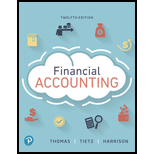
Concept explainers
LO 1, 2
(Learning Objectives 1, 2: Show how to account for inventory in a perpetual system using the average-costing method) Eastern Trading Company purchases inventory in crates of merchandise; each crate of inventory is a unit. The fiscal year of Eastern Trading ends each January 31. Assume you are dealing with a single Eastern Trading store in San Diego, California. The San Diego store began the year with an inventory of 24,000 units that cost a total of $1,272,000. During the year, the store purchased merchandise on account as follows:
| Jul (29,000 units at $55) ...................................... | $1,595,000 |
| Nov (49,000 units at $59) .................................... | 2,891,000 |
| Dec (59,000 units at $65) .................................... | 3,855,000 |
| Total purchases .................................................... | $8,321,000 |
Cash payments on account totaled $7,993,000. During fiscal year 2018, the store sold 149,000 units of merchandise for $15,272,500, of which $4,700,000 was for cash and the balance was on account. Eastern Trading and all of its stores use the average-cost method for inventories. The San Diego store’s operating expenses for the year were $4,250,000. It paid 70% in cash and accrued the rest as accrued liabilities. The store accrued income tax at the rate of 40%.
Requirements
1. Make summary
2. Prepare a T-account to show the activity in the Inventory account.
3. Prepare the store’s income statement for the year ended January 31, 2018. Show totals for gross profit, income before tax, and net income.
Want to see the full answer?
Check out a sample textbook solution
Chapter 6 Solutions
Financial Accounting Plus MyLab Accounting with Pearson eText -- Access Card Package (12th Edition)
- Mit Distributors provided the following inventory-related data for the fiscal year: Purchases: $385,000 Purchase Returns and Allowances: $10,200 Purchase Discounts: $4,300 Freight In: $55,000 Beginning Inventory: $72,000 Ending Inventory: $95,500 What is the Cost of Goods Sold (COGS)?arrow_forwardanswer ? general accountingarrow_forwardBrightTech Corp. reported the following cost of goods sold (COGS) figures over three years: • 2023: $3,800,000 • 2022: $3,500,000 • 2021: $3,000,000 If 2021 is the base year, what is the percentage increase in COGS from 2021 to 2023?arrow_forward
- Sun Electronics operates a periodic inventory system. At the beginning of 2022, its inventory was $95,750. During the year, inventory purchases totaled $375,000, and its ending inventory was $110,500. What was the cost of goods sold (COGS) for Sun Electronics in 2022?arrow_forwardi want to this question answer of this general accountingarrow_forwardA clothing retailer provides the following financial data for the year. Determine the cost of goods sold (COGS): ⚫Total Sales: $800,000 • Purchases: $500,000 • Sales Returns: $30,000 • Purchases Returns: $40,000 • Opening Stock Value: $60,000 • Closing Stock Value: $70,000 Administrative Expenses: $250,000arrow_forward
- subject : general accounting questionarrow_forwardBrightTech Inc. had stockholders' equity of $1,200,000 at the beginning of June 2023. During the month, the company reported a net income of $300,000 and declared dividends of $175,000. What was BrightTech Inc.. s stockholders' equity at the end of June 2023?arrow_forwardQuestion 3Footfall Manufacturing Ltd. reports the following financialinformation at the end of the current year: Net Sales $100,000 Debtor's turnover ratio (based on net sales) 2 Inventory turnover ratio 1.25 fixed assets turnover ratio 0.8 Debt to assets ratio 0.6 Net profit margin 5% gross profit margin 25% return on investments 2% Use the given information to fill out the templates for incomestatement and balance sheet given below: Income Statement of Footfall Manufacturing Ltd. for the year endingDecember 31, 20XX(in $) Sales 100,000 Cost of goods sold gross profit other expenses earnings before tax tax @ 50% Earnings after tax Balance Sheet of Footfall Manufacturing Ltd. as at December 31, 20XX(in $) Liabilities Amount Assets Amount Equity Net fixed assets long term debt 50,000 Inventory short term debt debtors cash Total Totalarrow_forward
 Financial AccountingAccountingISBN:9781337272124Author:Carl Warren, James M. Reeve, Jonathan DuchacPublisher:Cengage Learning
Financial AccountingAccountingISBN:9781337272124Author:Carl Warren, James M. Reeve, Jonathan DuchacPublisher:Cengage Learning
